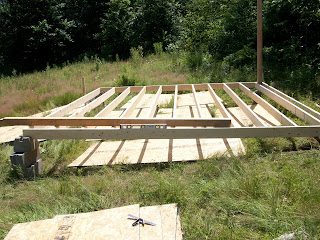As we prepare our Fall garden, I've been mulling over how far-reaching the ability to produce one's own food truly is. Growing your own food may be the single most important thing that one can do to promote freedom. By growing your own food, you:
- Take control over the quality, variety, nutritional value, and safety of your food supply.
- Reduce the amount of fuel spent transporting, cooling, and warehousing food.
- Save money that can be reallocated to debt reduction, investing in land, equipment for off-grid living, homeschooling supplies, or to simply hold in savings.
- Reduces the amount of money being fed into the Broken System.
The first three items are reason enough to grow a least a portion of your food. But, you may not have heard about the fouth. The Broken System is actually a network of systems. This network includes entities like the government, as well as health care, financial and food industries, and so on. Each of these entities share two things
- a gross lack of accountability to the American public,
- are wasteful, and operate in an unsustainable manner.
Considering the size to which these entites and industries have been permitted to grow, we are left with few real options with which to reign them in. The most powerful tool we have to take back control is through individual spending habits.
Career politicians, lending institutions, and giant manufacturers try desperately to get us to spend money. It keeps them strong, while keeping the general population weak with debt. But we have a choice whether to listen to them, or to listen to our common sense.
What we need to do is stop spending! Stop listening to the nonsense that it is supposedly patriotic to spend money you can't afford to spend. According to who? Here's the truth: it's patriotic to create strong, debt-free, American families. We can reduce our spending by growing some or all of our own food. You end up with more money in your pocket and better quality food at the same time.
There is a tremendous amount of waste of fuel and energy to grow food on large Agri-business farms, and especially on imported food from foreign countries. More fuel and energy is then wasted in the packaging, shipping, and warehousing of food. All of the fuel and utilities necessary to keep this process afloat is taxed and a source of government income. Considering that most produce travels an average of 1500 miles from farm to store shelves, that's a lot of tax revenue.
I do not know anyone who thinks the government has spent our tax dollars wisely. Yet, even with a completely different party in control of both congress and the White House, we are still subjected to the Patriot Act, paying for a horrendously expensive war, and bailing out companies and banks as a reward for mismanagement. Voting differently certainly didn't do much to help us.
The most effective way to create change is to change our spending habits. By growing our own food, we are refusing to feed into the Broken System. Growing our own food reduces our dependence on foreign oil. Growing our own food is an act of patriotism.
Live better, a little every day.











